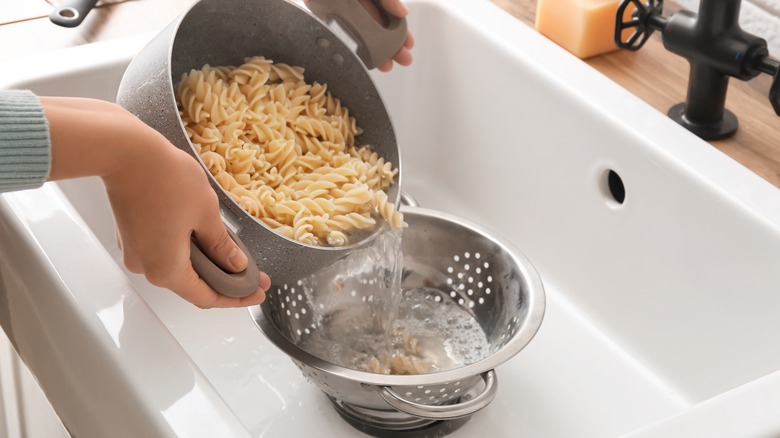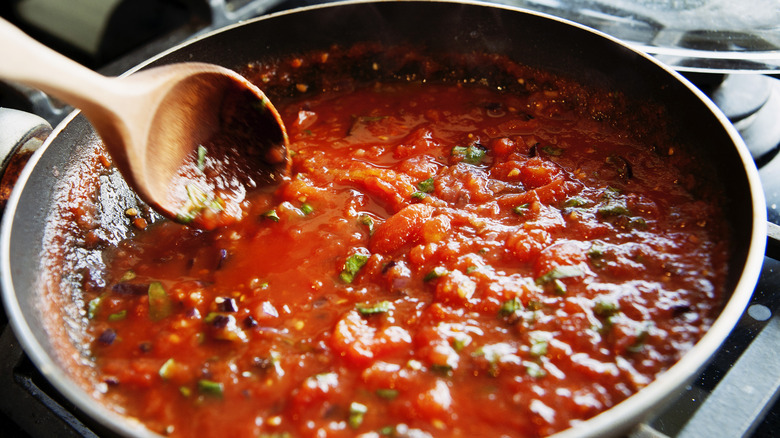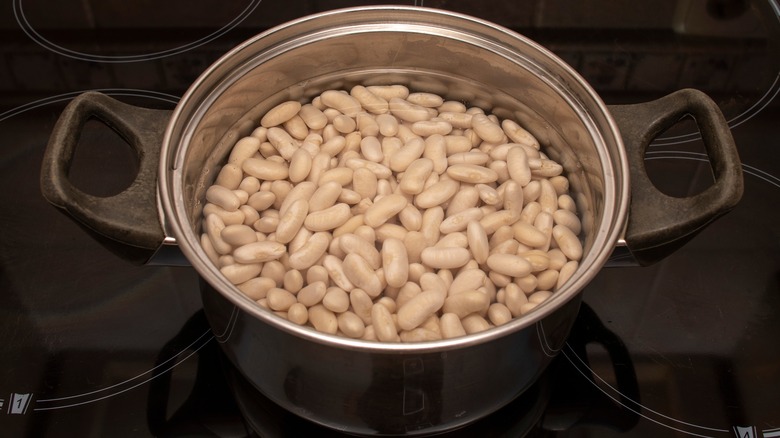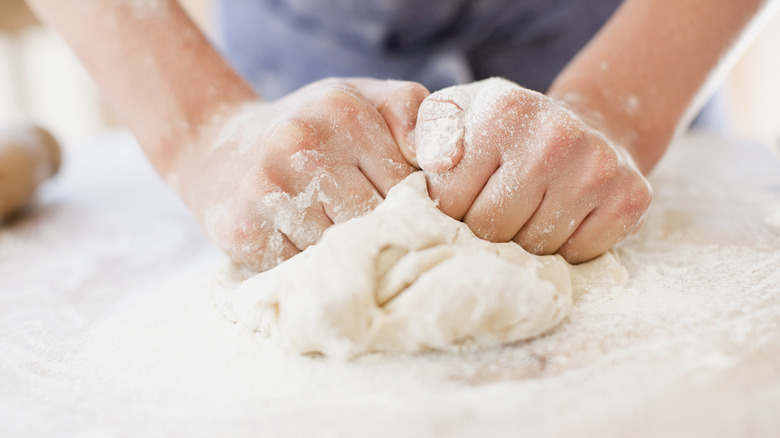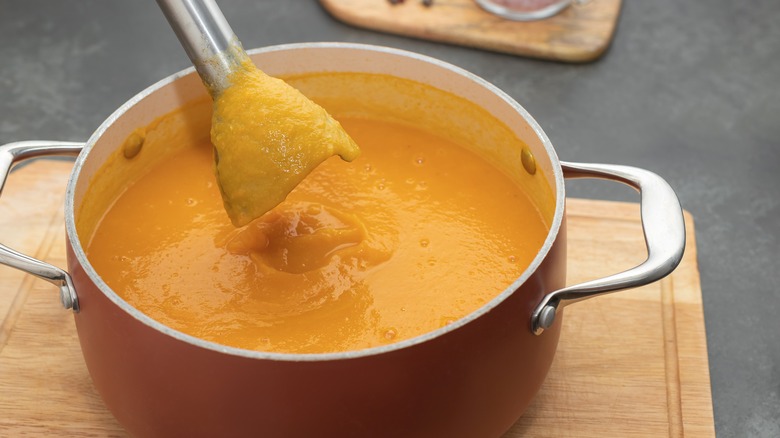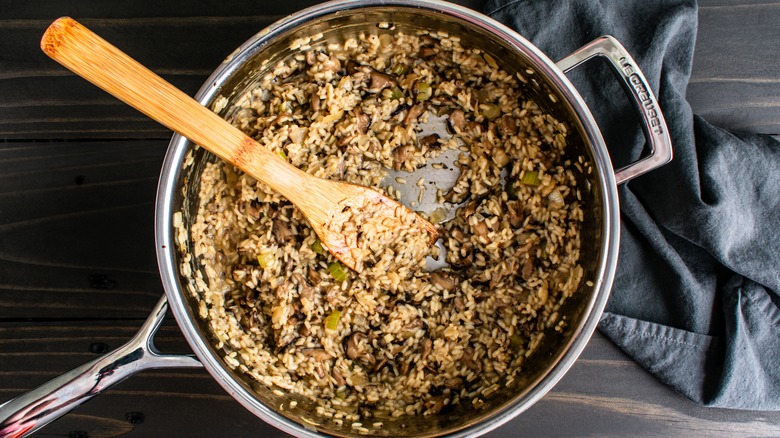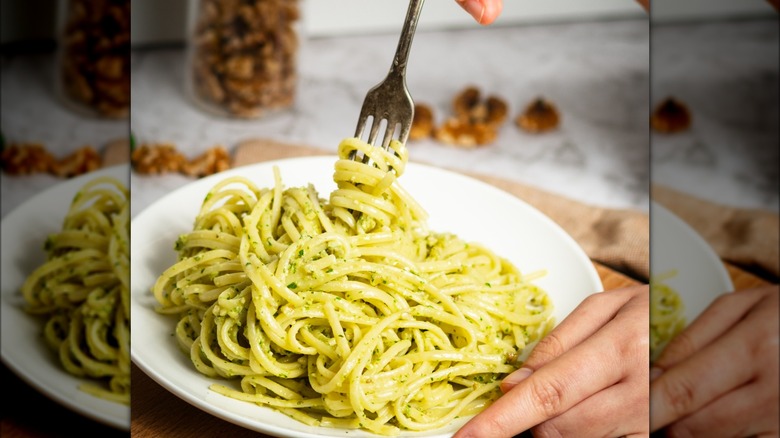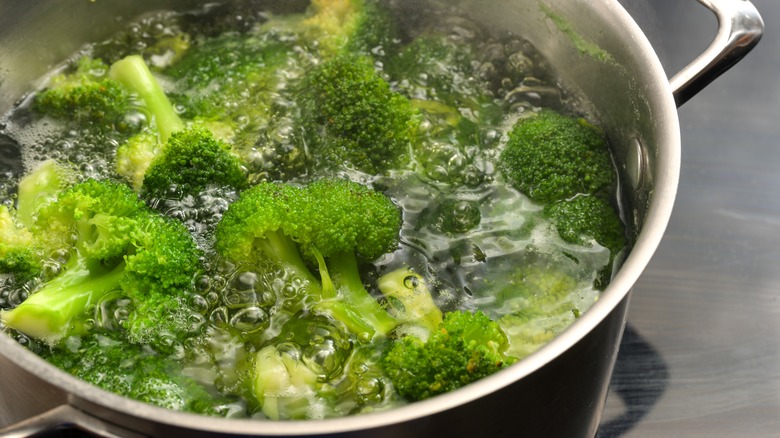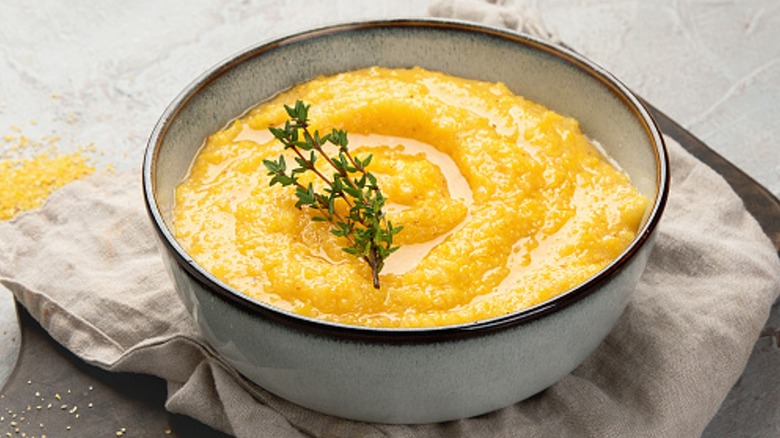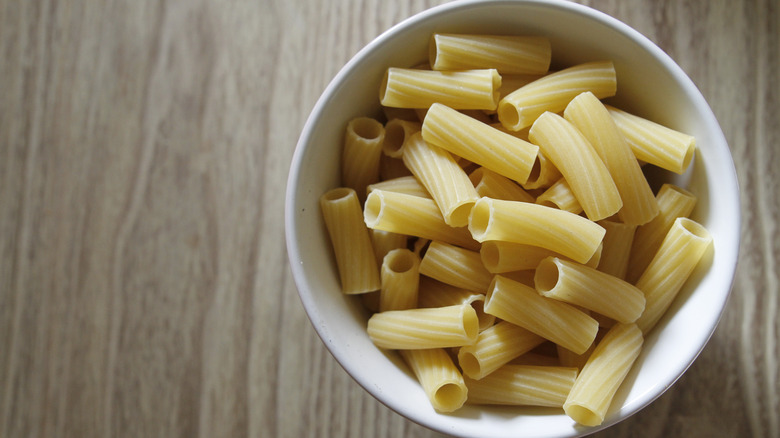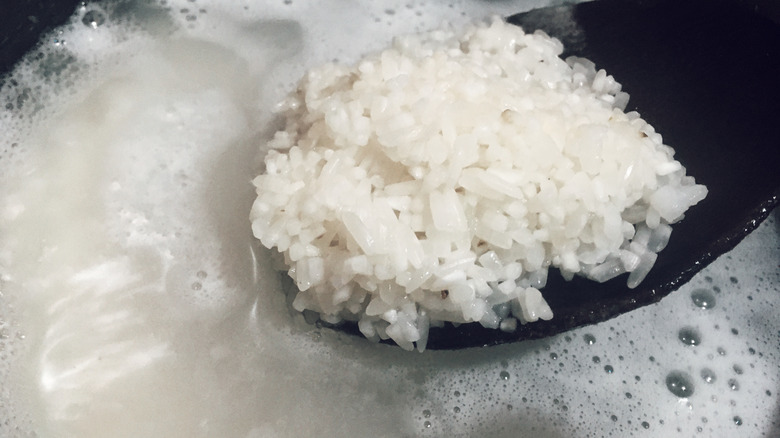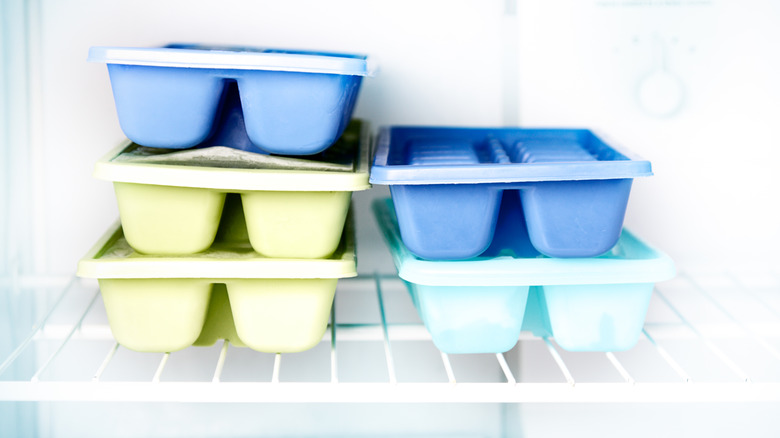4 Experts Lay Out Helpful Uses For Leftover Pasta Water
From spaghetti with meat sauce, macaroni and cheese, stroganoff, and so many other dishes, pasta is an integral part of many people's lives. If you like preparing pasta, there is one key mistake you may be making: pouring the pasta water down the drain after your spaghetti, ziti, macaroni, or other pasta has finished cooking. While many see the water simply as the vessel in which the pasta is cooked, it is actually good for so much more than just this task.
To help us learn more about the wonder of pasta water, we reached out to four expert chefs. Leah Ferrazzani, the Founder and owner of Semolina Artisanal Pasta and Ferrazzani's Pasta & Market, Matt Harding, the Senior Vice President of Culinary and Menu Innovation at Piada Italian Street Food, Chef George Duran, a celebrity chef, comedian, and entertainer, and Galen Zamarra, the co-founder of Galen Hospitality Group, all offered up these excellent suggestions on the ways you can put this "liquid gold" as Ferrazzani calls it, to work for you.
Save pasta water for making sauces
The next time you prepare pasta, be sure to save some of the pasta water for your sauce. Just as choosing the best type of tomatoes for your homemade pasta sauce can help you create a better-finished product, so too can using a little pasta water. Chef Galen Zamarra says, "I am a big fan of using pasta water in my pasta sauces. It is a great way to adjust consistency, and the water that has starches leaked from the pasta helps thicken or add viscosity to a sauce."
According to Zamarra, this is a simple trick that will not only help thicken the sauce, but also build on its flavor profile and recapture the nutrients. He explains that adding the pasta water to the sauce "should be done naturally though, while your pasta is cooking just add a few ladles to your sauce."
Use pasta water when soaking and cooking beans
Soaking beans and other legumes before cooking them is often recommended. This produces several benefits, including softening hard legumes, improving the texture, and ensuring they are easier for your body to digest (i.e., less gas). Chef George Duran highlights pasta water as a top choice when choosing a liquid for soaking legumes. He explains, "When you soak beans or lentils in pasta water before cooking them, the residual starch and salt in the pasta water will help soften the legumes more efficiently than plain water. This will reduce the cooking time and enhance the flavor of the legumes."
Leah Ferrazzani is also a fan of using pasta water to soak beans in. She explains that the pasta water's "starch will make a thicker pot likker" (the liquid left after soaking and cooking the beans." If you want to try this hack, Chef Duran says, "Remember to soak and cover the legumes with the pasta water for several hours or overnight." This will give the pasta water plenty of time to soften the beans, ensuring the best taste and texture when you prepare them the following day.
Swap plain water for pasta water when making bread
Another surprising use for pasta water is in making bread. Both Matt Harding and George Duran suggested this potential use as a reason to save some of your leftover pasta water. Duran explains, "Replacing the pasta water in your bread dough with pasta water can improve the dough's consistency and elasticity. This will give your bread a better crumb structure and flavor too." He recommends measuring the same amount of pasta water as plain water in the recipe.
Harding points out another benefit of swapping plain water for starchier pasta water the next time you prepare homemade bread. He says, "The starch in the water contributes to a crispier crust and better structure, especially in focaccia compared to sourdough." Harding recommends letting the pasta water cool to about 70 degrees Fahrenheit before adding it to your mixing bowl with the other ingredients for the bread.
Use pasta water to thicken soups
If you've ever been disappointed that your homemade soup turned out too thin and runny, you may have been missing the secret ingredient: a little pasta water. Leah Ferranzzani and George Duran share that pasta water is a natural ingredient for thickening stews and soups. Ferrazzani says, "By cooking your pasta in the broth for your pasta e fagioli, you end up with something thicker and more substantial, so why not apply this to other dishes — beef and chicken stews can benefit from a little pasta water as a thickener rather than cornstarch, and it's better than unresolved flour."
Duran recommends adding a little pasta water instead of regular water when your soup is simmering. He says, "Add pasta water regularly until you achieve your desired consistency. The starch in the pasta water is a natural thickening agent that will give the soup a richer and silkier texture."
Try leftover pasta water for making risotto
Risotto is a slow-cooked Italian rice dish with a deliciously smooth and creamy texture. The recipe often features cheese and butter, which further enhance the flavor. However, these ingredients are options. Other additions, such as mushrooms or spinach, are also common, but not necessary. While risotto is traditionally made using broth, you can also try making it using pasta water to replace some of the broth called for in your recipe. Matt Harding explains that this approach "adds creaminess to the dish, especially when you substitute half of your chicken or vegetable stock with pasta water."
Chef Duran explains that "the starch in the pasta water will help create a creamy texture and also add an extra layer of flavor to the dish." Whether you've had risotto several times or have never cooked it before, you might want to try now that you know this little secret.
Add pasta water to pesto to make it stick
Rinsing pasta is a crucial mistake that you should avoid. When you rinse pasta, you're washing away the starch that helps ensure the sauce sticks to it and does not simply slide right off. Adding a little pasta water to your pesto has the same effect. After cooking the pasta, Leah Ferrazzani says, "Just put over your pesto with a ladleful of hot pasta water. The heat in the water will melt the fat in the pesto (if it's cold) and help loosen the sauce enough to coat the pasta while adding the starch to make it stick!"
Before attempting this hack, it is important to note that not all experts agree about its potential benefits. Galen Zamarra believes that the shape of the pasta itself is the most important thing to pay attention to if you want to make sure your sauce adheres properly. He explains, "Pasta cut with a bronze die adds a texture to the pasta to help hold sauce. Most commercial pastas are cut with massive machinery, which creates a smoother pasta sauce [that] doesn't stick well too. Also, the type/shape of pasta is specific to a dish or sauce because of how it holds the sauce, rather than what shape looks cool." If all else fails, you could always try Giada De Laurentiis' trick using some parmesan cheese to help sauce stick to your pasta.
Blanch or steam vegetables in pasta water
You can conserve water by reusing your pasta water to blanch or steam vegetables. Beyond reducing the amount of water you consume, Chef George Duran explains that this hack can deliver additional benefits compared to using plain water. He says, "The nutrients and salt from the pasta water can enhance the flavor of the vegetables." You could save the water for blanching the veggies after you've drained the pasta, or even consider putting your steamer directly over the pot of pasta as it cooks. Your entire dinner could be ready to enjoy in just a few minutes.
There are a few potential downsides to steaming the vegetables over the pot that you'll want to consider before giving this hack a try. Galen Zamarra explains, "When vegetables steam, they release things back into the water. Sometimes that might be full of nutrients and flavor." You'll want to closely consider which vegetables you're trying to steam over the pasta to prevent the transfer of unpleasant flavors. Or, if you're a purist like Zamarra, maybe skip this approach altogether. "I try to get the most out of foods' inherent flavors — I want the pasta to taste like pasta and broccoli to taste like broccoli," he says.
Save pasta water to make polenta
"One of my aunts always saves pasta water to make polenta. The starch in the water adds a wonderful texture and flavor," shares Matt Harding. Never tried polenta? It is a traditional Italian dish that originated in the country's northern region. It is typically made with ground flint corn but may also be made using other varieties of corn.
Making a traditional polenta involves boiling salted water, broth, or a combination of broth and water to a boil before adding the ground cornmeal. If using pasta water, swap out the other liquids at a 1:1 ratio. Once combined, the ingredients should simmer, giving the cornmeal time to absorb the liquid. The finished dish can be eaten straight from a bowl (its texture is similar to grits) or served with other toppings. If you've never tried preparing polenta, it is certainly worth trying. And, as Harding suggests, subbing in pasta water is a sure-fire way to enhance the overall taste of the finished product.
Reserve pasta water to rehydrate dried out pasta
You're preparing a pasta dish to serve for dinner. The pasta finishes cooking a few minutes before you're ready to serve it, and by the time you go to add it to your plate, it has dried out and started clumping together. If you've used the correct amount of water when you boil pasta and it still happens, pasta water can save the day, once again, and help you breathe new life into dried-up cooked pasta.
This is one of Chef George Duran's top tips for pasta water. He says, "When making a pasta dish, always reserve a cup of pasta water so if your pasta dries out, you can rehydrate it a little at a time with pasta water." When adding the water back to your pasta, work slowly. You don't want to inadvertently add too much and end up with a soupy mess that will dilute any sauce you introduce to the dish.
Reuse the salty water to cook rice
Another way you can prevent your pasta water from going to waste is by saving it to reuse the next time you want to cook rice. Pasta water has already been salted and seasoned, and Leah Ferrazzani says, "The seasoned water will help make flavorful rice."
When using pasta water to prepare rice, there are a few important things to remember. First, you always want to bring the water to a boil before adding the rice. As with cooking pasta, putting rice in a cold pot of water can cause the grains to cook unevenly. Otherwise, the outside of the rice may be soft and fluffy, while the inside is still too hard to enjoy. Next, know the correct ratio of rice to water. This ratio can change slightly based on the rice you're preparing. For many types of rice, you'll want to use twice as much water as rice (so 3 cups of water for 1.5 cups of rice). However, sometimes, you may want to use slightly less water if you want a fluffier and chewier rice (only 1.5 times as much water as rice).
For the added flavor pasta water brings, simply swap plain water for pasta water. Another secret for making fluffy rice is to add a splash of vinegar as the rice cooks.
Freeze some pasta water to use later
Now that you've learned so many ways that pasta water can enhance a variety of other dishes, you're probably excited to try some of them. But what if you're not planning on cooking rice, sauce, polenta, or any of the other dishes on this list in the near future? Well, don't fret. But don't let that precious pasta water go to waste by pouring it down the drain. "If you pour pasta water in ice cube trays and freeze them, you'll be able to use these cubes in a pinch to enrich your soups, sauces, or stews." explains Chef George Duran.
To freeze pasta water, simply pour it into an ice cube tray and place it in the freezer. The following day, after the cubes have had a chance to freeze completely, pop them out of the tray and put them into a labeled freezer-safe bag. This will not only help conserve space but also help ensure that the pasta water stays fresh and doesn't pick up any other food odors. Plan to use your frozen pasta water within six months for optimal freshness. Saving and freezing your pasta water will set you up for various future cooking endeavors. Plus, you won't have to worry about finding a substitute for accidentally-dumped pasta water the next time you're making spaghetti.
